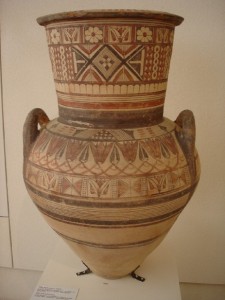After having been involved with Anthroposophy for years, and having some familiarity with biodynamic farming, I am only just now listening to recordings of the agricultural lectures. I have often thought that an anthroposophical practice could be developed and applied to ceramic art work, similar to the way it is applied to painting and the other arts, but also uniquely dealing with the mineral kingdom, and the nature of clay and clay materials. These lectures are a good starting point. Steiner’s discussions on lime, silica, and clay are extremely applicable. The finishing processes in ceramics deviate somewhat from the processes in agriculture, incorporating the element of fire and it’s trans-formative properties. So the question might arise: “How does a fired form still carry anything living into the world past the firing process, which essentially kills any potential for organic growth”. A simple explanation might be interpolated from the question: “What living qualities still exist in archaic ceramic forms from 1,000-10,000 years ago”. Objects from the past still seem to retain spiritual qualities inherent at the time of the making as well as from subsequent use and history. The object as vessel, whether purely sculptural or also functional, acts as both receiver and disseminator of cosmic and earthly spirit. The maker, like the clay in soil, acts as facilitator and, to the extent they have developed their own spiritual existence, help determine the effect and spiritual nature of the object/vessel and sculptural form and as a mediator between matter and spirit. Artistic endeavor is, in this respect, a communicator across time. Clay rises up in the forming processes, lime and other fluxes flow downward into the spaces in the firing, both in glaze and in clay. “Killing” the clay with fire leaves a spiritual space for giving and receiving spirit, similar to processes in the soil and in digestive processes in the human and animal kingdoms.
Joman Pottery, Archaic Japanese

Chinese, Five Dynasties Covered Jar, 12th-13th century
Song Dynasty celadon porcelain with a fenghuang spout, 10th century, China.
Nigerian pottery water jar – William Itter collection
Geometric amphora, 760-750 B.C., The National Archaelogical Museum, Athens
Minoan Octopus Vessel, ca. 1500 BCE [ca. 1450 BCE ceramic, 11” high
Kolomoki Mounds Effigy vessels
 Portrait Head Vessel Moche, Peru, fifth to sixth century CE
Portrait Head Vessel Moche, Peru, fifth to sixth century CE
Mesoamerican Colima Dog effigy
Water jar traded into the Rio Grande Delta area from the region of Tampico, Mexico.
A.D. 1100-1700. http://www.texasbeyondhistory.net/brownsville/index.html











